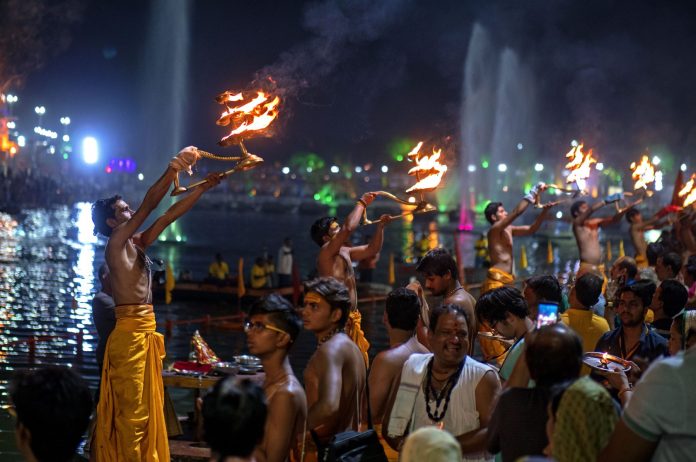The mass pilgrimage at Kumbh Mela unites Hindus in a splendid showcase of faith and devotion
Text Shirin Bhandari
Photos Gunther Deichmann
The Hindu devotee’s hands are pressed together. His palms touch, close to his chest, and his fingers point upwards. His brightly-coloured turban is in stark contrast to his thick white beard. “Namaste,” he says with a slight bow. Literally translated, the word means “I bow to the divine in you.” A respectful greeting, namaste, or namaskar, combined with the wordless hand gesture, conveys the same meaning of acknowledgement for a loved one, a guest or a stranger, regardless of the speaker’s language, culture or religion. Amidst the potpourri of more than 1,500 languages spoken in India, namaste is a universal form of salutation, understood by all, and particularly so during the Kumbh Mela. The left-to-right head wobble – would that be a yes or a no? – is another story!

It is a Sensory Overload
India is not for the faint-hearted. It is sensory overload; there are no grey areas: either you’ll love to travel the country or hate it well enough to take the first flight out. India can break you with its poverty, lack of privacy and dirt; ironically, Western travellers claim to have found inner spirituality after a two-week trip. The Kumbh Mela – the largest spiritual gathering in the world, when Hindus gather en masse to bathe in a sacred river and cleanse themselves of sin – is the ultimate test.
First documented by a Chinese traveller in the seventh century, the colourful celebration of the world’s oldest religion is held once every 12 years. The exact date of the festival is determined according to a combination of the zodiac positions of Jupiter, the sun and the moon.
Hindu mythology describes how the Lord Vishnu dropped the drink of immortality over four locations as he was transporting it in a kumbha (pot), hence the name. The Mela (gathering) is centred at the banks of a river where devotees bathe to cleanse themselves of their sins. The main festival site is, of course, located on the banks of a river: the Ganges at Haridwar; the confluence of the Ganges and Yamuna and the invisible Sarasvati at Allahabad; the Sarasvati at Allahabad; the Godavari at Nashik; and the Shipra at Ujjain.

The Kumbh Mela is a melting pot of the millions of people that visit from the various states who, despite speaking diversely different languages, converge peacefully in the name of religion. The event is widely known by its Sanskrit name, Kumbha, the sacred language of Hinduism and a ceremonial language in pujas (prayers) and religious rituals. Sanskrit is the sacred language of Hinduism and one of the oldest Indo-European languages in the world. The literature holds a deep tradition in drama, poetry, religious and philosophical texts.
As such, Sanskrit hymns and chants are widely heard throughout the Kumbh Mela. Kumbha is also – fittingly – the sign of the Aquarius.
Ujjain
The Kumbh Mela in Ujjain can be traced back to the 18th century. The ancient city, considered one of the most sacred places in India, sits along the eastern bank of the Kshipra River and is located in the state of Madhya Pradesh in central India. It is as if time has stood still here. Visitors travel to India on planes, trains and automobiles, then transfer to more eclectic, old-world modes of transportation: camels, horses, even elephants. The devotees are from all walks of life, from various castes and religious orders – Hindus, Buddhists, Sikhs, even Christian missionaries – with one purpose: to bathe and be born again, freed into an eternal life without sin and suffering. Between 22 April and 21 May 2016, approximately 75 million people visited.
The main temple of reverence in Ujjain is the Mahakaleshwar Jyotirlinga, situated on the side of the Rudra Sagar Lake. It is one of the most famous Hindu temples dedicated to Lord Shiva, and is said to be one of twelve jyotirlingams that is the most sacred abode of Lord Shiva. The Ram Ghat – one of the most popular – is located close to the Harsiddhi Temple in Ujjain. Indian astronomers have calculated that the Tropic of Cancer passes through the city of Ujjain, making it the Greenwich of India.
The Peoples
The largest crowd-pullers at the Kumbh Mela are the sadhus or the holy men of India. The root word sadh in Sanskrit means ‘to reach one’s goal’; the same word is used in the sadhana, or spiritual practice. Becoming a sadhu is the fourth stage in a Hindu’s life, and the practice is also open to women (sadvi). Coming from a variety of castes, the holy people of India practise a nomadic life and their spiritual discipline involves self-denial: renouncing the world for meditation and contemplation.
Living apart from society – in Hindu temples, ashrams, forests and caves – the sadhus focus on their yogic and spiritual beliefs. Some of them thrive in large communes while others choose a more reclusive lifestyle. They rely on donations from people to survive. It is a difficult path and sadhus are considered legally dead unto themselves and to India. Regardless, it is believed that their devotion is good karma and beneficial to Indian society.
The nanga (naked) sadhus, with their thick dreadlocks and ash-covered skin, claim to be in the company of ghosts. They certainly look the part. India has an infinite amount of rituals and traditions that can lead one to God. Their choice to live in cemeteries as part of their holy path is, however, macabre. Some are thought to possess special powers. The fascination with the Lord Shiva explains their heavy use of charas (cannabis), who was thought to have a deep affinity for the plant.
Most devotees at the event are draped in brightly-coloured fabrics, though marigold is predominant, and beads of different shapes and sizes, often mixed with silver, adorn their necks and wrists. Tents of various hues fill the horizon. Fragrant food stalls serve only vegetarian cuisine so that nobody is offended. The smell of musky incense mixed with ganja (marijuana) fills the air. The stairs leading down to the body of water are full of people patiently waiting their turn in the river. The nanga sadhus flock to bathe, proving that one can detach from worldly things. The outcome is an overwhelming, unexpected and extraordinary visual feast.
Every 144 years, a Maha (great) Kumbh Mela occurs. It is said that in 2013, more than 120 million pilgrims attended the Maha Kumbh Mela in Allahabad within a span of two months. The gathering was so huge that it was visible from space!
Whatever the reasons for the pilgrimage, the Kumbh Mela has proven for centuries that it embodies the Indian spirit. From this whirlwind of activities and swirl of languages and cultures, faith – together with the timeless journey towards forgiveness and redemption – is the one factor that unites people.
For more stories and photographs from this issue, check out Asian Geographic Issue 120.











